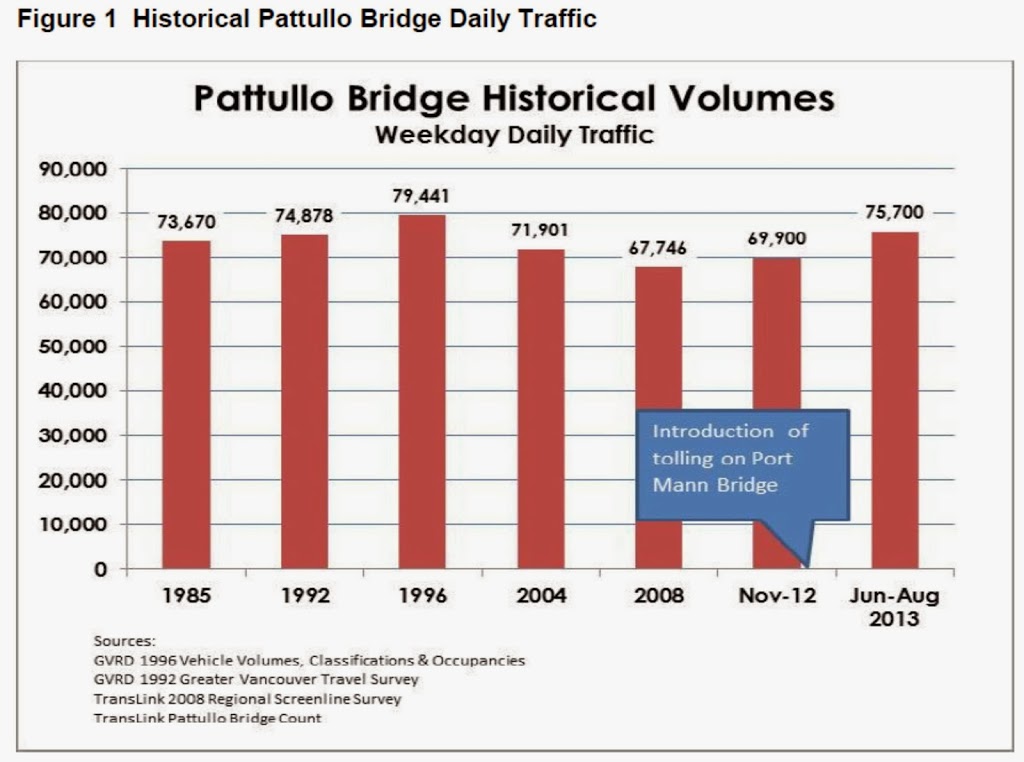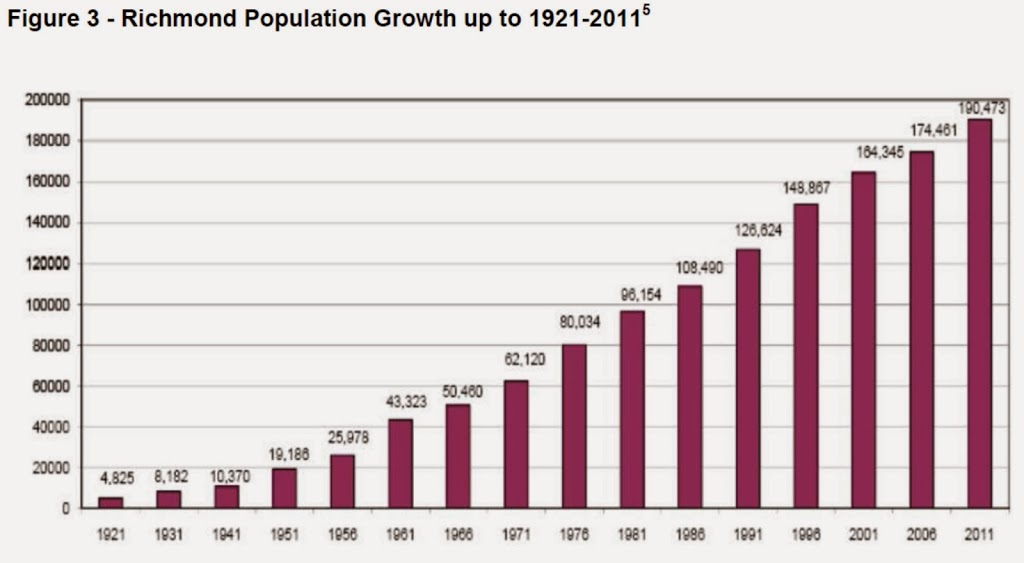This is a really good document.
I don’t want to go through the many reasons why I agree with the City of New Westminster’s position on the Pattullo Bridge, because I have said it all here before. For those new to my blog (Hi Tiffany!), there is a longish summary here.
If you really want the background from my viewpoint, you can read this, or this, or the two-part piece I did comparing the Pattullo to the Lion’s Gate that is here and here, or maybe look at this or this, or any of the other hundred posts about the transportation situation in our dear city I have slogged through over the last 5 years. But this is not about me, this is about the City of New Westminster finally laying their cards on the table, and in doing so, showing that they are holding a hell of a good hand.
New Westminster is clear that anything larger than a 4-lane bridge is undesirable. Surrey has stated that they prefer a 6-lane bridge. The difference, as explained in this 40-page volume put together by the City of New Westminster, is that the problem set which was agreed to by all parties (New Westminster, Surrey, and TransLink) more than a year ago does not support the building of a 5- or 6-lane bridge. Also, those larger options come with costs, both monetary costs that could be better invested in Transit South of the Fraser, and livability costs on New Westminster.
You can get the gist from reading the 4-page Executive Summary, and I think anyone interested in the topic of traffic in New Westminster and/or the future of the Pattullo Bridge really needs to read those 4 pages before commenting at length about New Westminster being “NIMBY” or “parochial” about this topic. I’m including you, Mayor Stewart. However, there are rewards for digging deeper into this position paper, because it actually provides data to back up its assertions.
After a review of the consultation and planning process to date (reminding TransLink once again that they don’t have a bridge-too-small problem, they have a bridge-too-old problem), the City lays out the case that there is no need for increased capacity as the problem is solved. To back this up, they demonstrate that the traffic volumes on the bridge were stable, or even declining until tolls arrived on the adjacent bridge, and the Ministry of Transportation started installing signs telling people to drive through New Westminster to save a few bucks.
 |
| All graphs here cribbed from the City report. |
The City is also right to point out that the number of crossings of the river is increasing at such an (exponential?) rate that it is hard to rely on any modeling of actual or projected growth until new patterns establish themselves. I tracked the crossings back to 1900, they stuck to the more recent data:
 |
| I didn’t even ask permission to crib them from the report. |
Despite the rise in crossings, people still argue that more lanes are required to facilitate growth. I have heard Vancouver used as an example of growth not requiring more roads, but the City decided to look at the Richmond example, pointing out how it paradoxically grew by more than 50% since the last time there was any significant bridge construction (with the notable exception of the SkyTrain Bridge!)
 |
| but hey, i’m a taxpayer, so I paid for the report. |
In Sections 3.3 and 3.4 of the report, it is demonstrated that the building of a higher-capacity bridge is not supported by TransLink’s own Regional Transportation Strategy or the Regional Growth Strategy, and in fact counters those strategies by inducing development that is counter to the region’s goals. If any part of this report is weak, this is it, only because the City seems reluctant to toot its own horn. So I’ll do the tooting here.
New Westminster has the second-highest “alternative mode share” of any city in the Lower Mainland, second only to the City of Vancouver. This means that New Westminster residents are leading the region in finding alternatives to driving cars for their work commute, for shopping, or for school. New Westminster is building the compact, transit-oriented, pedestrian-friendly City that is outlined in the regional transportation and land use plans.
When Surrey says New Westminster is being intractable and a terrible regional partner, the point needs to be retorted, firmly, with bold print, underlined and in contrasting colour: How is doing exactly what our regional partners have agreed is the best course an example of being a bad partner!?! It is time Surrey started looking at their own choices: utterly failing to protect farmland; continuing to build unsustainable auto-oriented neighbourhoods; for continuing to threaten the livability of the entire region. When is the region going to start to question Surrey about the ways it is falling short in the “regional partner” relationships department?
This is why the City of New Westminster is taking the “Reasonable Approach” of asking TransLink and the Province to take the money that is being set aside for the Pattullo Bridge replacement, and invest it in helping Surrey meet its regional commitments.
I am also happy the City took a direct approach to the “Killer Bridge” stigma of the Pattullo. I have written about this meme and its accessory suggestion that the Pattullo must be replaced because it is so dangerous. The City effectively demonstrates this is not the case, and once again relies not on hearsay or platitudes, but the actual numerical data:
 |
| So I don’t feel bad having lifted them, at least I’m citing them. |
The New Westminster report then goes through a comprehensive discussion of the preferred options, and touches on a number of aligned issues in the region and the City. This includes the current hot-button topic of truck impacts on New Westminster streets. On this topic, the report pulls out this provocative quote:
“It is of interest to note that on the other side of the Fraser River, the issues of truck traffic appear to have been substantially addressed. An article in BC Business reporting observations made by Jim Cox, then-CEO, Surrey development Corporation, noted ‘Cox gives full credit to Watts and her big-picture vision, such as changing the name of King George Highway to King George Boulevard, and creating South Fraser Perimeter Road to divert all that ugly truck traffic away from the heart of the city, making the streets walkable for the first time in Surrey’s car-loving history.‘ It is also worth noting that the costs of the South Fraser Perimeter Road have been covered by the Province.”
At the same time Surrey is touting the removal of trucks from it’s neighbourhood streets on the Province’s dime, it is advocating that the Province spend more money to put those same trucks on New Westminster’s neighbourhood streets.
I also liked that New Westminster included a statement on building a well-designed bridge, reflecting its importance as an icon in our skyline and a major piece of infrastructure in the middle of an urban neighbourhood:
“If a new structure is to be built, it should be the subject of an architectural design competition in which the cities of Surrey and New Westminster are full participants. If a rehabilitation option is chosen, attention should be paid in the design and maintenance processes to improve significantly the present appearance of the
bridge.”
And yes, the City of New Westminster has come down clearly and firmly in favour of tolling the Pattullo bridge, both as a revenue generator to pay for the replacement of refurbishment, and also as a “leveling of the playing field”, to end this unfortunate phase where our neighbourhood streets are deemed the cheap alternative to paying for road infrastructure through tolls.
Even better, with flat growth of traffic and tolls on a refurbished 4-lane or new 4-lane bridge, there will likely be no need for senior government money to build the project. As the Report summarizes:
“As the Pattullo Bridge Strategic Review indicated that the rehabilitated 4-lane option and the new 4-lane option can be self-funded through tolling, there is the question whether senior government funding is necessary if one of these options is selected. The reality is that public money that is spent on the bridge will restrict the ability to fund other much needed projects such as the Light Rail Transit (LRT) system within Surrey. The City is supportive of reallocating capital cost saving from a rehabilitated 4-lane bridge project or a new 4-lane bridge project to the much needed rapid transit system in the City of Surrey.”
So in summary: The City of New Westminster does not care if the Pattullo if refurbished or replaced, as long as it is tolled, has no more than 4 lanes, and is build in such a way that respects the urban character of the neighbourhoods and the importance of this structure to the region’s history. Not just because that is what the City wants, but because that solution fits the problem analysis best, saves senior governments money, meets regional goals, and reflects the values of our regional community in 2014. Compared to this well-assembled, well-supported, and comprehensive analysis, Surrey’s completely unsupported “More Bridge now!” argument is embarrassing.
Now to my major point: TransLink is stuck in neutral, Surrey is lobbying senior governments, and the Minister of Transportation sounds like he is listening. New Westminster has now presented a solid case, and will be taking this forward to those interested parties. The City needs your help. Get this report to your Residents’ Association meeting and get them to write a short letter of support to Mayor and Council. Are you active in the PAC in your local school? Ask then to also write a letter of support, and ask your school board to do the same. I hope the Downtown BIAs and the Chamber of Commerce, and even my friends at the NWEP can also get a letter together ASAP and show that this position is not that of a few people on Council, but is the position of a united, involved, informed, and proactive community.
TransLink cancelled the consultations that were supposed to be occurring right now in New Westminster to discuss the future of the Pattullo, but let’s make them hear from us anyway.
I just did as you suggested, and wrote a letter indicating my support for a 4-laned replacement with a toll. I’d prefer a modest toll on the Pattullo, and a reduction of the Port Mann – it would remove any economic incentives, and let the drivers use the most convenient bridge.
A bit ominous though that Translink, on commenting about the George Massey Bridge, stated that tolls are needed to curb use, or bridge capacity will be maxed out too soon.
Using this logic, expect to see a high toll on not only the Massey, but a new Pattullo as well.
And I guess we can kiss goodbye the idea of a universal $1 a crossing toll to spread the pain.